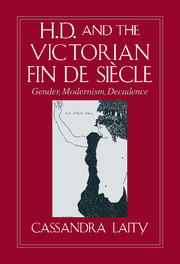Book contents
- Frontmatter
- Contents
- Acknowledgments
- Introduction: Dramatis Personae: The Aesthete Androgyne and the Femme Fatale
- 1 The Rhetoric of Anti-Romanticism: Gendered Genealogies of Male Modernism
- 2 H.D.'s Early Decadent Masks and Images: HER; Sea Garden
- The Aesthete Androgyne
- The Femme Fatale
- 5 Toward a Revised Myth of Origins: From the Diaphanous Androgyne to the Abject Femme Fatale
- 6 From Agon to “Héros Fatale”: Pre-Raphaelite Transformations of Male Modernism/Modernity
- 7 Feminine Abjection and Trilogy
- Postscript
- Notes
- Index
- CAMBRIDGE STUDIES IN AMERICAN LITERATURE AND CULTURE
6 - From Agon to “Héros Fatale”: Pre-Raphaelite Transformations of Male Modernism/Modernity
Published online by Cambridge University Press: 06 January 2010
- Frontmatter
- Contents
- Acknowledgments
- Introduction: Dramatis Personae: The Aesthete Androgyne and the Femme Fatale
- 1 The Rhetoric of Anti-Romanticism: Gendered Genealogies of Male Modernism
- 2 H.D.'s Early Decadent Masks and Images: HER; Sea Garden
- The Aesthete Androgyne
- The Femme Fatale
- 5 Toward a Revised Myth of Origins: From the Diaphanous Androgyne to the Abject Femme Fatale
- 6 From Agon to “Héros Fatale”: Pre-Raphaelite Transformations of Male Modernism/Modernity
- 7 Feminine Abjection and Trilogy
- Postscript
- Notes
- Index
- CAMBRIDGE STUDIES IN AMERICAN LITERATURE AND CULTURE
Summary
Even as Freud compelled H.D. to rediscover the daughter's love for the mother, he also brought about a necessary redefinition of the father: Loving the mother enabled H.D. to imagine a marginalized male culture of sympathetic fathers and brothers ouside the punitive Law of the Father that seemed everywhere in male modernism/modernity. If the later H.D. refigured the mother after the abject femme fatale – H.D. raved over Swinburne's Lucretia Borgia shortly after she began Helen in Egypt – she reconceptualized the father/brother as a twin-deject after the Pre-Raphaelite “héros fatale.” Like H.D.'s Helen, the exiled Achilles of Helen in Egypt enters the Egyptian scene similarly attired in abjection. “The Body, / wounded, stricken,” lamed by the arrow that lodged in “the bruised and swollen flesh” of his vulnerable heel, Achilles limps after “the bereft” femme fatale. She then proceeds, as DuPlessis succinctly observes, “to perform a rescue operation” on Achilles, releasing him from the “iron ring” of a proto-Fascism and accommodating him back to the mother Thetis (“Romantic Thralldom” 417). H.D. specifically linked the “Achilles of the Helen sequence” with what she described as “the héros fatale” of her Pre-Raphaelite novels, which included “The Sword Went Out to Sea” and “White Rose and the Red” (Compassionate Friendship 30). No longer poising herself as boy in relation to a Greek homoerotic continuum of her male contemporaries, H.D. pronounced the Pre-Raphaelite woman's feminine (male) double, “Le Prince Lointoin” to be her latest “personification of the lost companion, the twin” that had appeared with “each turn of [her life's] spiral” (“The Sword” 119).
- Type
- Chapter
- Information
- H. D. and the Victorian Fin de SiècleGender, Modernism, Decadence, pp. 150 - 169Publisher: Cambridge University PressPrint publication year: 1996



